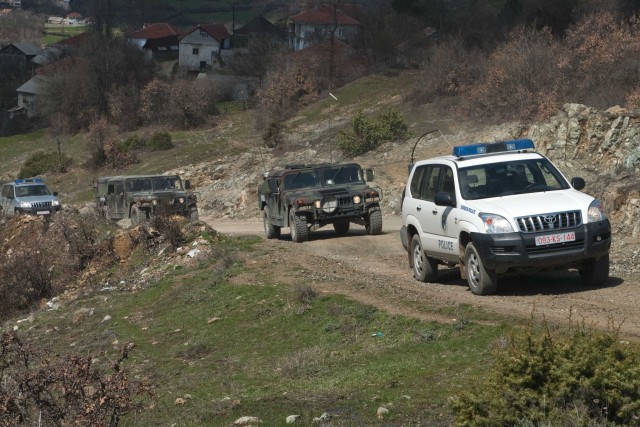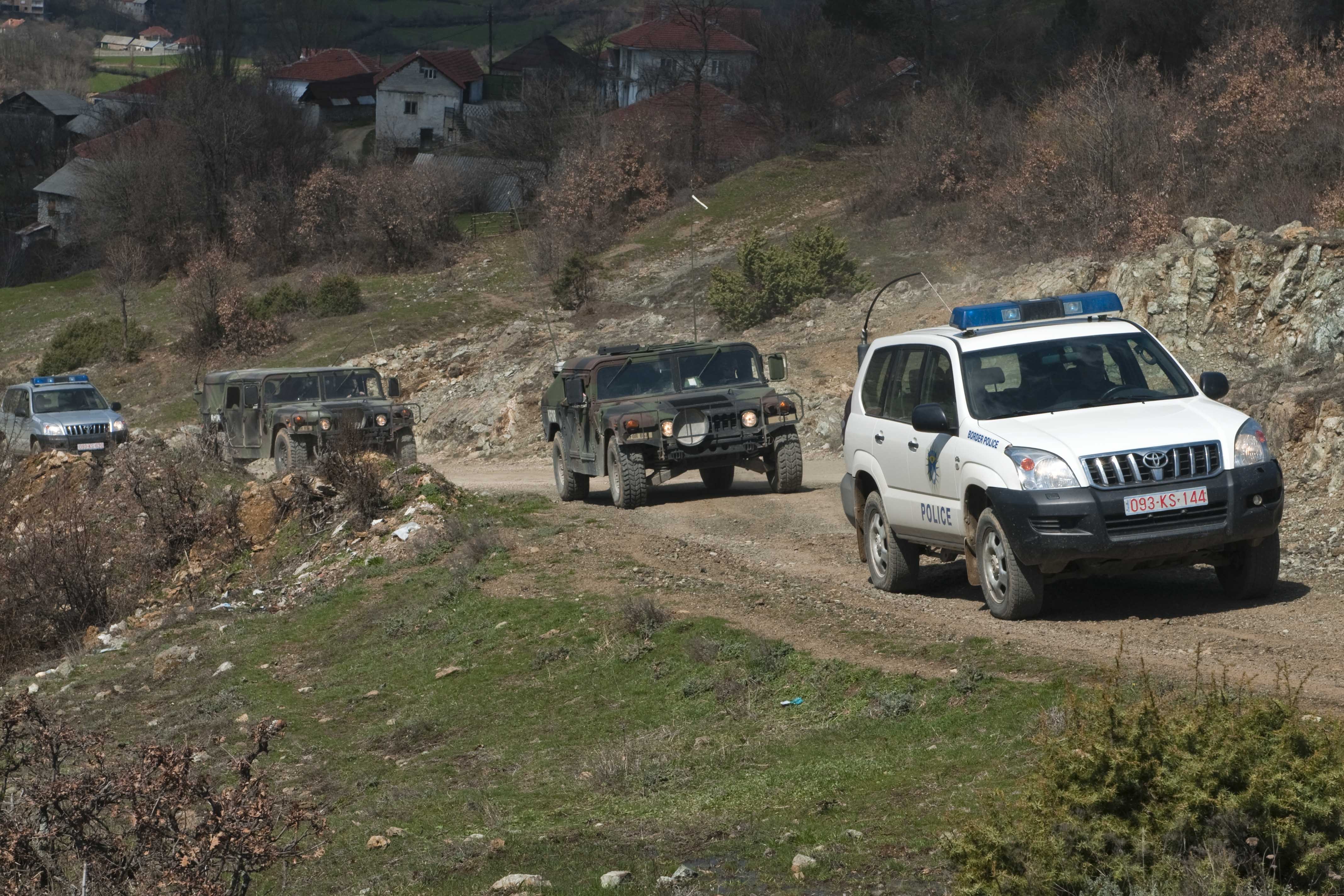On June 9, 1999, the Military Technical Agreement (MTA) among
the International Security Force, KFOR, and the Governments of
the Federal Republic of Yugoslavia and the Republic of Serbia was signed and
passed. This agreement had far reaching implications, including the cession of
hostilities between the parties involved, but also the establishment of an Administrative
Boundary Line (ABL) separating KFOR forces and the Serbian Armed Forces
(SAF). It was deemed necessary for Serbia and KFOR to maintain and watch the
ABL, so Section 4 of the MTA outlined the establishment of the Joint Implementation
Commission (JIC) within KFOR in order to liaison with the nation of Serbia and
the SAF. In the performance of its duties, the JIC plays one of the most vital roles
in KFOR's mission to maintain a safe and secure environment and embrace change.
The JIC monitors the border areas around Kosovo as well.
The JIC has sections in all five Multi National Battle Group's throughout
Kosovo. The JIC section for Multi National Battle Group-East is a five person team,
led by the JIC Chief, Col. Peter Conlin, Bismarck, N.D. Conlin is assisted by the
Deputy JIC Chief Capt. Shane Clennon of Fargo, N.D., non commissioned officer
in charge (NCOIC) Master Sgt. Kyle Heidenreich Fargo, N.D., assistant NCOIC
Sgt. Melissa Bartholomay Fargo, N.D., and the administrative specialist Spc. Adam
Schwehr, Beulah, N.D. Conlin emphasized the importance of every member of the
team.
"It's definitely a team effort," said Conlin. "You need every person. Everyone
has very distinct responsibilities. The deputy does a lot of the local level
meetings and monitors patrols. The NCO handles all of the logistics, the
communications, the operation, the admin, and then, of course, a lot of the tasks go
down to both the assistant NCO and the admin specialist."
What makes the JIC such a unique organization is the fact that it does not
exist anywhere outside of KFOR, where it was created by the MTA. As Heidenreich
explained, at the start of the preparation for this deployment, he didn't know what they
would be doing.
"Everybody else knew exactly what they were doing, because that's what they
do," said Heidenreich. "The maneuver forces, they know what they do. What's
a JIC' Everybody says 'what's a JIC'' The only place the JIC is found is here in Kosovo. There are no JIC units. There's no MOS training for units. There's nothing. It's unique to Kosovo and the MTA that was established in 1999. In fact, I had no clue what it was when I first got into the
unit. Nobody really knew what it did."
As he settles into his duties, however, Heidenreich has grown fond of the work
they perform.
"I think it's very interesting," he said. "You get to meet with people from the
Serbian Armed Forces (SAF). We monitor the boundary; we know what's going on.
We don't have any authority. We can't task people to do anything. We're just an
overwatch of what happens around the ABL."
The other responsibilities of the JIC consist of attending meetings with commanders on each side of the ABL and the border with the Former Yugoslav Republic of Macedonia (FYROM)
surrounding Kosovo. The purpose of these meetings is to deal with any issues related
to crossings of the border or boundary, as well as to act as a liaison between each
country and KFOR. Conlin explained the evolution of their duties and meetings.
"Essentially what the JIC allows people to do is allow the Serbs to talk directly to
the KFOR forces. " Conlin said. "The JIC simply facilitates [communication]. Also,
there was no real established protocol at the time to talk with the border countries like
FYROM or Albania, so KFOR mandated that the JIC establish meetings with them
as well, so the FYROM border police had a means of communicating with the Kosovo
border police."
The members of the JIC act as military diplomats. Though the JIC is unique to
KFOR, the principles it operates under, in a diplomatic capacity, have existed in some
form throughout history.
"Historically, of course, the idea of military diplomats has always existed,"
said Conlin. "You'd see generals sit down with other generals of opposing forces to
talk. So, that concept is nothing new. From our perspective, the SAF isn't so much of
an opposing force, but more of an adjacent force, so, that's really the difference in thiscase."
The JIC's meetings with the SAF are some of the most important duties
it performs. They hold several monthly meetings with SAF leaders at all levels
in order to work through any issues or concerns either organization has. They also
use these meetings to set up synchronized patrols between the two forces in order to
improve security along the ABL. Conlin said the main purpose of the meeting is
to provide a safe and secure environment for everyone, and Brig. Gen. Milosav
Simovic, the Commander of the 4th Army Brigade for the SAF, who attends the
command level meetings with Brig. Gen. Alan Dohrmann, commander of MNBG-E,
agrees that the work done at these meeting helps the region.
"Our synchronized patrols improve security in the region a lot," Simovic said.
"Also, our meetings on local, coordination and command levels make our cooperation
better and they help us perform our tasks better."
The synchronized patrols symbolize how KFOR and the SAF have come
together to form a relationship in order to tackle a problem they are both facing. The
building and maintaining of relationships is the key role the JIC must fill. The
cooperation between the two countries is a cornerstone of the relationship that
has been built over the years for the accomplishment of a common goal.
"We aren't adversaries," said Heidenreich. "We are partners. We share
information. We both are here for the same purpose, which is to ensure a safe
boundary. That there is no smuggling going on across it; that there's no criminal activity
going on."
One of the constants throughout the SAF's relationship with KFOR has been
Col. Branislav Pavic, the SAF's Chief of the Team for Cooperation with KFOR.
Pavic has been with the team since the very beginning, starting in 1999. Through his
time working with the JIC, Pavic has noted the growth of the cooperation between the
teams.
"Today's level of cooperation is very high compared to the level at the time
when we began," Pavic said. "In short, when we began the cooperation with the
members of the American contingent of KFOR, that cooperation was based only on
signed agreements and protocols. As time was going by, that level of cooperation
was being elevated and every new rotation of KFOR would elevate that level to one
step higher. We can say that the level of cooperation with KFOR 12 is exceptionally
well and will probably be elevated further by the time they end this mandate here."
The relationship that has formed has been improved by the shared goals
and similarities between the groups.
Heidenreich expressed the respect he has for the SAF and the way they conduct
themselves while accomplishing the mutual goals.
"They take it very seriously what they do; they are very professional. And
we do too, because it is a serious deal," said Heidenreich. "But it's safe. We have
no reason to doubt anybody. Once the meetings are over, you can talk to them.
They have no problem with that. They're proud of it. They're proud of their services.
They're proud of their Army. They're soldiers. They're professionals."
Sgt. Melissa Bartholomay expanded on how the camaraderie between the groups
helps in the accomplishment of a theme embossed on bracelets worn by many
MNBG-E soldiers.
"We're the 'peacemakers' right'" she said. "We're trying to make peace
with other countries. We make friends with other people. Not only do we attend
meeting with the SAF, but we have lunch with him. We're making peace with other
countries."
Meeting with people and the establishment of strong relationships
is how the JIC is able to fill its role in KFOR's overall mission. Heidenreich
expressed his happiness for the experiences he has received and the people he has met
while working with the JIC and how the JIC works toward KFOR's overarching
purpose.
"It's a good mission," he said. "We meet with different people and that's what makes
the job interesting. It's not the same thing over and over again. Meeting other people
and getting their point of view and trying to express your point of view, and seeing
how they all fit together. The whole reason KFOR is here is to promote stability and
peace in the region. And that's what we do."


Social Sharing